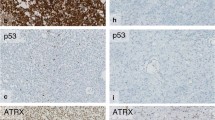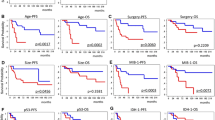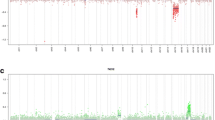Abstract
“Oligoastrocytoma” disappeared as of the revised fourth edition of the World Health Organization Classification of Tumours of the Central Nervous System, except where appended with “not otherwise specified (NOS)”. However, histopathological and genetic backgrounds of cases with dual features of astrocytoma/oligodendroglioma have been sparsely reported. We encountered a 54-year-old man with right frontal glioma comprising two distinct parts on imaging and histopathological examination: grade 4 astrocytoma with IDH1-R132H, ATRX loss, p53-positivity and intact 1p/19q; and oligodendroglioma with IDH1-R132H, intact ATRX, p53-negativity and partially deleted 1p/19q. At recurrence, histopathology showed low-grade mixed astrocytic and oligodendroglial features: the former with IDH1-R132H, ATRX loss, p53-positivity and intact 1p/19q and the latter showing IDH1-R132H, intact ATRX, p53-negativity and 1p/19q codeletion. At second recurrence, histopathology was astrocytoma grade 4 with IDH1-R132H, ATRX loss, p53-positivity and intact 1p/19q. Notably, 1p/19q codeletion was acquired at recurrence and CDKN2A was deleted at second recurrence. These findings suggest insights into tumorigenesis: (1) gliomas with two distinct lineages might mix to produce “oligoastrocytoma”; and (2) 1p/19q codeletion and CDKN2A deletion might be acquired during chemo-radiotherapy. Ultimately, astrocytic and oligodendroglial clones might co-exist developmentally or these two lineages might share a common cell-of-origin, with IDH1-R132H as the shared molecular feature.



Similar content being viewed by others
Change history
19 January 2023
A Correction to this paper has been published: https://doi.org/10.1007/s10014-023-00449-6
References
Perry A (2001) Oligodendroglial neoplasms: current concepts, misconceptions, and folklore. Adv Anat Pathol 8(4):183–199
Nasrallah MP, Desai A, O’Rourke DM, Surrey LF, Stein JM (2020) A dual-genotype oligoastrocytoma with histologic, molecular, radiological and time-course features. Acta Neuropathol Commun. https://doi.org/10.1186/s40478-020-00998-3
Huse JT, Diamond EL, Wang L, Rosenblum MK (2015) Mixed glioma with molecular features of composite oligodendroglioma and astrocytoma: a true “oligoastrocytoma”? Acta Neuropathol (Berl) 129(1):151–153
Qu M, Olofsson T, Sigurdardottir S et al (2007) Genetically distinct astrocytic and oligodendroglial components in oligoastrocytomas. Acta Neuropathol 113(2):129–136
Wilcox P, Li CC, Lee M et al (2015) Oligoastrocytomas: throwing the baby out with the bathwater? Acta Neuropathol 129(1):147–149
Mellai M, Annovazzi L, Senetta R et al (2017) Diagnostic revision of 206 adult gliomas (including 40 oligoastrocytomas) based on ATRX, IDH1/2 and 1p/19q status. J Neurooncol 131(2):213–222
Suvà ML, Tirosh I (2020) The glioma stem cell model in the era of single-cell genomics. Cancer Cell 37(5):630–636
Takayanagi S, Mukasa A, Tanaka S et al (2017) Differences in genetic and epigenetic alterations between von Hippel-Lindau disease–related and sporadic hemangioblastomas of the central nervous system. Neuro Oncol 19(9):1228–1236
Arita H, Yamasaki K, Matsushita Y et al (2016) A combination of TERT promoter mutation and MGMT methylation status predicts clinically relevant subgroups of newly diagnosed glioblastomas. Acta Neuropathol Commun 4(1):1–14
Louis DN, Perry A, Reifenberger G et al (2016) The 2016 World Health Organization Classification of Tumors of the Central Nervous System: a summary. Acta Neuropathol 131(6):803–820
Louis DN, Perry A, Wesseling P et al (2021) The 2021 WHO classification of tumors of the central nervous system: a summary. Neuro Oncol 23(8):1231–1251
Sahm F, Reuss D, Koelsche C et al (2014) Farewell to oligoastrocytoma: in situ molecular genetics favor classification as either oligodendroglioma or astrocytoma. Acta Neuropathol 128(4):551–559
Maintz D, Fiedler K, Koopmann J et al (1997) Molecular genetic evidence for subtypes of oligoastrocytomas. J Neuropathol Exp Neurol 56(10):1098–1104
Zepeda-Mendoza CJ, Vaubel RA, Zarei S et al (2020) Concomitant 1p/19q co-deletion and IDH1/2, ATRX, and TP53 mutations within a single clone of “dual-genotype” IDH-mutant infiltrating gliomas. Acta Neuropathol 139(6):1105–1107
Barresi V, Lionti S, Valori L, Gallina G, Caffo M, Rossi S (2017) Dual-genotype diffuse low-grade glioma: is it really time to abandon oligoastrocytoma as a distinct entity? J Neuropathol Exp Neurol 76(5):342–346
Mac Lean PN, Desai A, O’Rourke DM, Surrey LF, Stein JM (2020) A dual-genotype oligoastrocytoma with histologic, molecular, radiological and time-course features. Acta Neuropathol Commun 8(1):1–6
Funding
This work was supported in part by Japan Brain Foundation.
Author information
Authors and Affiliations
Corresponding author
Ethics declarations
Conflict of interest
The authors report no conflict of interest.
Additional information
Publisher's Note
Springer Nature remains neutral with regard to jurisdictional claims in published maps and institutional affiliations.
The original online version of this article was revised due to the corresponding author's name was processed incorrectly and corrected in this version.
Rights and permissions
Springer Nature or its licensor (e.g. a society or other partner) holds exclusive rights to this article under a publishing agreement with the author(s) or other rightsholder(s); author self-archiving of the accepted manuscript version of this article is solely governed by the terms of such publishing agreement and applicable law.
About this article
Cite this article
Takami, H., Mukasa, A., Takayanagi, S. et al. Morphologically, genetically and spatially mixed astrocytoma and oligodendroglioma; chronological acquisition of 1p/19q codeletion and CDKN2A deletion: a case report. Brain Tumor Pathol 40, 26–34 (2023). https://doi.org/10.1007/s10014-022-00448-z
Received:
Accepted:
Published:
Issue Date:
DOI: https://doi.org/10.1007/s10014-022-00448-z




